Related Research Articles

Major General Richard Jaquelin Marshall was a senior officer in the United States Army.
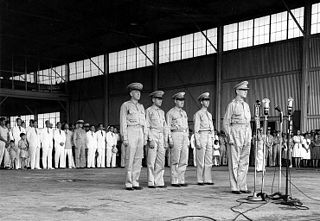
United States Army Forces in the Far East (USAFFE) was a military formation of the United States Army active from 1941 to 1946. The new command's headquarters was created on 26 July 1941, at No. 1, Calle Victoria, Manila, Luzon, the Philippines, with General Douglas MacArthur as commander. The Chief of Staff was Brigadier General Richard K. Sutherland and the Deputy Chief of Staff was Lieutenant Colonel Richard J. Marshall. The core of this command was drawn from the Office of the Military Advisor to the Commonwealth Government of the Philippines.

Del Monte Field was a heavy bomber airfield of the Far East Air Force (FEAF) of the United States Army Air Forces, located on Mindanao in the Philippines. The airfield was located in a meadow of a Del Monte Corporation pineapple plantation.
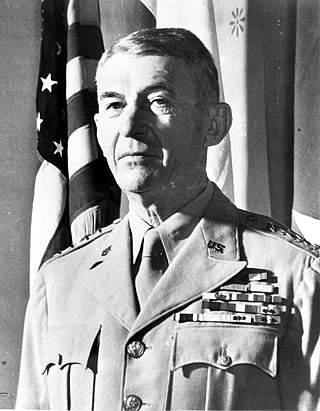
Walter Krueger was an American soldier and general officer in the first half of the 20th century. He commanded the Sixth United States Army in the South West Pacific Area during World War II. He rose from the rank of private to general in the United States Army.
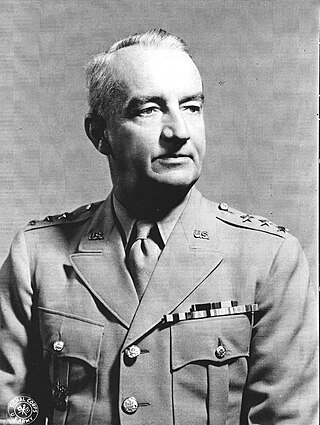
Robert Lawrence Eichelberger was a general officer in the United States Army who commanded the Eighth United States Army in the Southwest Pacific Area during World War II.

The Philippines campaign, also known as the Battle of the Philippines or the Fall of the Philippines, was from December 8, 1941, to May 8, 1942, the invasion of the Philippines by the Empire of Japan and the defense of the islands by United States and the Philippine Armies during World War II.

Wendell Fertig was an American civil engineer, in the American-administered Commonwealth of the Philippines, who organized and commanded an American-Filipino guerrilla force on the Japanese-occupied, southern Philippine island of Mindanao during World War II. Fertig's widely scattered guerrilla force numbered approximately 32,000. He faced about 50,000 Japanese soldiers, mostly garrison troops in towns and cities.

The Borneo campaign or Second Battle of Borneo was the last major Allied campaign in the South West Pacific Area during World War II to liberate Japanese-held British Borneo and Dutch Borneo. Designated collectively as Operation Oboe, a series of amphibious assaults between 1 May and 21 July 1945 were conducted by the Australian I Corps, under Lieutenant-General Leslie Morshead, against Imperial Japanese forces who had been occupying the island since late 1941 – early 1942. The main Japanese formation on the island was the Thirty-Seventh Army under Lieutenant-General Masao Baba, while the naval garrison was commanded by Vice-Admiral Michiaki Kamada. The Australian ground forces were supported by US and other Allied air and naval forces, with the US providing the bulk of the shipping and logistic support necessary to conduct the operation. The campaign was initially planned to involve six stages, but eventually landings were undertaken at four locations: Tarakan, Labuan, North Borneo and Balikpapan. Guerilla operations were also carried out by Dayak tribesmen and small numbers of Allied personnel in the interior of the island. While major combat operations were concluded by mid-July, mopping-up operations continued throughout Borneo until the end of the war in August. Initially intended to secure vital airfields and port facilities to support future operations, preparatory bombardment resulted in heavy damage to the island's infrastructure, including its oil production facilities. As a result, the strategic benefits the Allies gained from the campaign were negligible.
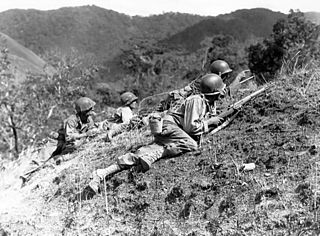
The Battle of Luzon was a land battle of the Pacific Theater of Operations of World War II by the Allied forces of the U.S., its colony the Philippines, and allies against forces of the Empire of Japan. The battle resulted in a U.S. and Filipino victory. The Allies had taken control of all strategically and economically important locations of Luzon by March 1945, although pockets of Japanese resistance held out in the mountains until the unconditional surrender of Japan. While not the highest in U.S. casualties, it is the highest net casualty battle U.S. forces fought in World War II, with 192,000 to 217,000 Japanese combatants dead, 8,000 American combatants killed, and over 150,000 Filipinos, overwhelmingly civilians who were murdered by Japanese forces, mainly during the Manila massacre of February 1945.

The Battle of Mindanao was fought by the Americans and allied Filipino guerrillas against the Japanese forces on the island of Mindanao in the Philippines as part of Operation VICTOR V. It was part of the campaign to liberate the Philippines during World War II. The battle was waged to complete the recapture of the southernmost portions of the archipelago from the Imperial Japanese Army.
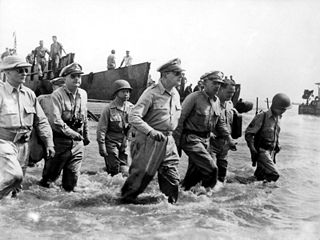
The Philippines campaign, Battle of the Philippines, Second Philippines campaign, or the Liberation of the Philippines, codenamed Operation Musketeer I, II, and III, was the American, Mexican, Australian and Filipino campaign to defeat and expel the Imperial Japanese forces occupying the Philippines during World War II.
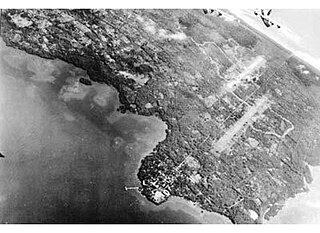
The Invasion of Palawan, was fought by U.S. liberation forces against the Japanese from 28 February to 22 April 1945, in a series of actions officially designated as Operations Victor I and II, and part of the campaign for the liberation of the Philippines during World War II, was waged to initiate the recapture of the southern islands of the Philippine archipelago, end the Japanese occupation, and secure them from remaining Japanese forces.

The Battle of Visayas was fought by U.S. forces and Filipino guerrillas against the Japanese from 18 March – 15 August 1945, in a series of actions officially designated as Operations Victor I and II, and part of the campaign for the liberation of the Philippines during World War II. The battle was waged to complete the recapture of the central portions south of the archipelago and secure them from remaining Japanese forces.

The South West Pacific theatre, during World War II, was a major theatre of the war between the Allies and the Axis. It included the Philippines, the Dutch East Indies, Borneo, Australia and its mandate Territory of New Guinea and the western part of the Solomon Islands. This area was defined by the Allied powers' South West Pacific Area (SWPA) command.

The Japanese occupation of the Philippines occurred between 1942 and 1945, when Imperial Japan occupied the Commonwealth of the Philippines during World War II.
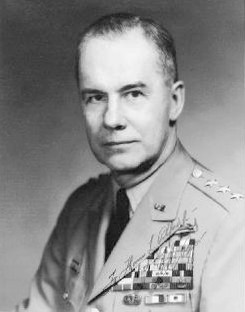
Lieutenant General Clovis Ethelbert Byers was a United States Army officer who served in the first half of the 20th century. He is best known for his role as Chief of Staff of the Eighth Army in the South West Pacific Area during World War II and in the occupation of Japan. He was wounded while leading American troops from the front at the Battle of Buna-Gona, and also played an important part in the fighting at Lone Tree Hill, Biak, and the Philippines campaign (1944–45).

Paul Bernard Wurtsmith was a United States Army Air Forces general during World War II.

On 11 March 1942, during World War II, General Douglas MacArthur and members of his family and staff left the Philippine island of Corregidor and his forces, which were surrounded by the Japanese. They traveled in PT boats through stormy seas patrolled by Japanese warships and reached Mindanao two days later. From there, MacArthur and his party flew to Australia in a pair of Boeing B-17 Flying Fortresses, ultimately arriving in Melbourne by train on 21 March. In Australia, he made a speech in which he declared, "I came through and I shall return".

During the Japanese occupation of the islands in World War II, there was an extensive Philippine resistance movement, which opposed the Japanese and their collaborators with active underground and guerrilla activity that increased over the years. Fighting the guerrillas – apart from the Japanese regular forces – were a Japanese-formed Bureau of Constabulary, the Kenpeitai, and the Makapili. Postwar studies estimate that around 260,000 people were organized under guerrilla groups and that members of anti-Japanese underground organizations were more numerous. Such was their effectiveness that by the end of World War II, Japan controlled only twelve of the forty-eight provinces.
Clarence Ames Martin was a highly decorated officer in the United States Army with the rank of Major General. A veteran of World War I, he distinguished himself as Company Commander in France and held various staff and field assignments during interwar period.
References
- Chant, Christopher (1986). The encyclopedia of codenames of World War II. Routledge: Oxford University Press. ISBN 0-7102-0718-2.